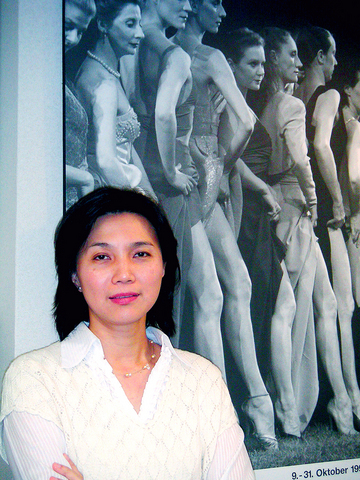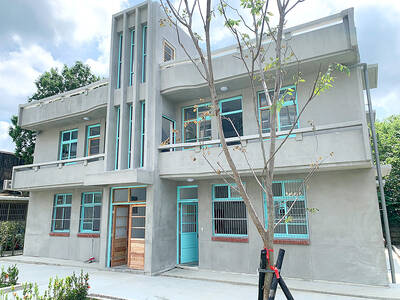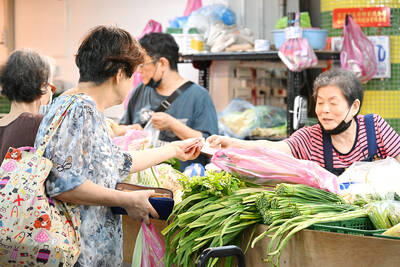Lai Hsiang-ling (賴香伶) is passionate about contemporary art. The mere mention of an installation or video projection are all that's needed to send the Museum of Contemporary Art's (MOCA, 台北當代藝術館) director off on a tangent about the diverse array of artists exhibiting in her museum or the curators she works with.
Drawing on 20-years of experience in Taiwan's culture industry, she can explicate at length about the minutiae of arts funding, the ups and downs of negotiating with policy wonks and the difficulties of squeezing money out of corporations. And it is her ability to communicate across a broad spectrum of institutions and disciplines that has made her the doyenne of Taiwan's contemporary art scene.
"From artists, administrators and corporate and art officials I need to work with them and communicate with them," she said in an interview with the Taipei Times.

PHOTO: COURTESY OF MOCA, TAIPEI
Appointed to the position in 2005, she began her two-year tenure last year after leaving the National Culture and Arts Foundation (NCAF, 國家文化藝術基金會), where she was director for grants.
"My friends always joke that before I gave money and now I always ask for money," she said.
For Lai, running a contemporary art museum means striking a balance between finding and working with curators who have a broad list of artist contacts and interacting with the community within which MOCA is based.
"Working with younger, emerging, artists and [finding] resources to work with different curators, younger emerging curators, while establishing MOCA as a platform that attracts artists working in cross-discipline to work are all goals I'm working towards," she said.
With four annual exhibits in the museum's main exhibition space and four smaller exhibits in the MOCA Studio, Lai has her hands full finding curators and mounting shows.
For MOCA's main exhibition space, Lai works with two kinds of "guest" curators all of whom have complete freedom to mount the shows they want. The first are what Lai calls the "scholarly curator," a person who writes a curator's statement and provides a list of artists, but does no hands-on work in setting up the exhibition. This becomes the responsibility of the museum's in-house curators, led by Lai.
Lai says this often causes problems because these curators often know little about MOCA's budget and size restrictions. As a result, she prefers to work with curators or institutions "based on some mutual understanding or mutual knowledge of working together before."
This often means that local guest curators are chosen over international guest curators because, "it's easier and safer to work with local guest curators."
Lai cites Manray Hsu (徐文瑞), curator of Naked Life and Sean Hu (胡朝聖), curator of the forthcoming Fashion Literally, as examples of young Taiwanese curators who can draw on a list of international artists operating in a global framework.
Like the curators she cultivates, Lai travels extensively throughout the globe to network with different curators and artists and keep abreast of art movements and museums.
"Because there's no one museum in the world ... information systems are important and you have to keep yourself updated and that's why museum and art community networking is very important," she said.
The three in-house curators work closely with Lai in the MOCA Studio. In addition to working on exhibits in the main gallery, each in-house curator is responsible for mounting an exhibit in the MOCA Studio, a space that was once a coffee shop that Lai single-handedly transformed into a space for emerging artists.
For Lai, the Studio benefits both the museum and emerging artists.
"Each year the three in-house curatorial staff members have to do one or two MOCA Studio exhibitions. They have to propose who will be the artist they will want to have and how to select their work and they have to write an exhibition essay," she said.
In addition to working with international curators, artists and art spaces, Lai also has to interact with the local community.
Lai continues MOCA's founding tradition of allowing staff and students of the school adjoining the museum free admission. She also works with the school to increase art education programs and encourage students to become tour guides.
Since last year, Lai has promoted the museum's plaza as a space to bring the community together with art fairs, unplugged concerts and movie screenings.
"These kinds of activities help to attract more people and opens a dialogue in the local community," she said.
In the future Lai will use the plaza's space to hold activities to promote exhibits at the museum.
Lai can't cite any one person who influenced her career as director. Instead she cites the Cartier Foundation in France as her inspiration because it was among the first institutions in the world to encourage contemporary art using guest curators.
"They already had the vision twenty years ago to see themselves as a platform for different kinds of art people to work together. That's my major interest — wherever I'm working. I should be that kind of person," she said.
MOCA is different than many museums in that it's only a showcase for art rather than a compiler of collections.
"What we call the four missions of a museum is: collection, exhibition, research, and education. Very few museums don't keep the four missions, and MOCA is one. Like P.S.1 in New York, we are very similar ... in that we don't have our own collection," she said.
Without a permanent collection MOCA has considerable freedom to develop its own unique voice through the curators they work with and the artist's work they exhibit. It is a mission that Lai embraces.
"[MOCA] is a kind of platform for art people to communicate, for the artists to be seen [and] for their artwork to be discussed, for curators to present their ideas and for critics to give their critical thinking about contemporary culture," she said.

June 2 to June 8 Taiwan’s woodcutters believe that if they see even one speck of red in their cooked rice, no matter how small, an accident is going to happen. Peng Chin-tian (彭錦田) swears that this has proven to be true at every stop during his decades-long career in the logging industry. Along with mining, timber harvesting was once considered the most dangerous profession in Taiwan. Not only were mishaps common during all stages of processing, it was difficult to transport the injured to get medical treatment. Many died during the arduous journey. Peng recounts some of his accidents in

“Why does Taiwan identity decline?”a group of researchers lead by University of Nevada political scientist Austin Wang (王宏恩) asked in a recent paper. After all, it is not difficult to explain the rise in Taiwanese identity after the early 1990s. But no model predicted its decline during the 2016-2018 period, they say. After testing various alternative explanations, Wang et al argue that the fall-off in Taiwanese identity during that period is related to voter hedging based on the performance of the Democratic Progressive Party (DPP). Since the DPP is perceived as the guardian of Taiwan identity, when it performs well,

The Taiwan People’s Party (TPP) on May 18 held a rally in Taichung to mark the anniversary of President William Lai’s (賴清德) inauguration on May 20. The title of the rally could be loosely translated to “May 18 recall fraudulent goods” (518退貨ㄌㄨㄚˋ!). Unlike in English, where the terms are the same, “recall” (退貨) in this context refers to product recalls due to damaged, defective or fraudulent merchandise, not the political recalls (罷免) currently dominating the headlines. I attended the rally to determine if the impression was correct that the TPP under party Chairman Huang Kuo-Chang (黃國昌) had little of a

At Computex 2025, Nvidia CEO Jensen Huang (黃仁勳) urged the government to subsidize AI. “All schools in Taiwan must integrate AI into their curricula,” he declared. A few months earlier, he said, “If I were a student today, I’d immediately start using tools like ChatGPT, Gemini Pro and Grok to learn, write and accelerate my thinking.” Huang sees the AI-bullet train leaving the station. And as one of its drivers, he’s worried about youth not getting on board — bad for their careers, and bad for his workforce. As a semiconductor supply-chain powerhouse and AI hub wannabe, Taiwan is seeing